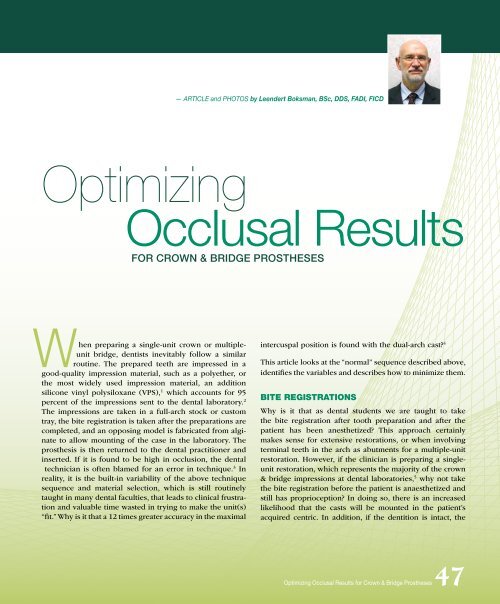PDF Version - Glidewell Dental Labs
PDF Version - Glidewell Dental Labs
PDF Version - Glidewell Dental Labs
Create successful ePaper yourself
Turn your PDF publications into a flip-book with our unique Google optimized e-Paper software.
— ARTICLE and PHOTOS by Leendert Boksman, BSc, DDS, FADI, FICD<br />
Optimizing<br />
Occlusal Results<br />
for Crown & Bridge Prostheses<br />
When preparing a single-unit crown or multipleunit<br />
bridge, dentists inevitably follow a similar<br />
routine. The prepared teeth are impressed in a<br />
good-quality impression material, such as a polyether, or<br />
the most widely used impression material, an addition<br />
silicone vinyl polysiloxane (VPS), 1 which accounts for 95<br />
percent of the impressions sent to the dental laboratory. 2<br />
The impressions are taken in a full-arch stock or custom<br />
tray, the bite registration is taken after the preparations are<br />
completed, and an opposing model is fabricated from alginate<br />
to allow mounting of the case in the laboratory. The<br />
prosthesis is then returned to the dental practitioner and<br />
inserted. If it is found to be high in occlusion, the dental<br />
technician is often blamed for an error in technique. 3 In<br />
reality, it is the built-in variability of the above technique<br />
sequence and material selection, which is still routinely<br />
taught in many dental faculties, that leads to clinical frustration<br />
and valuable time wasted in trying to make the unit(s)<br />
“fit.” Why is it that a 12 times greater accuracy in the maximal<br />
intercuspal position is found with the dual-arch cast? 4<br />
This article looks at the “normal” sequence described above,<br />
identifies the variables and describes how to minimize them.<br />
BITE REGISTRATIONS<br />
Why is it that as dental students we are taught to take<br />
the bite registration after tooth preparation and after the<br />
patient has been anesthetized? This approach certainly<br />
makes sense for extensive restorations, or when involving<br />
terminal teeth in the arch as abutments for a multiple-unit<br />
restoration. However, if the clinician is preparing a singleunit<br />
restoration, which represents the majority of the crown<br />
& bridge impressions at dental laboratories, 5 why not take<br />
the bite registration before the patient is anaesthetized and<br />
still has proprioception? In doing so, there is an increased<br />
likelihood that the casts will be mounted in the patient’s<br />
acquired centric. In addition, if the dentition is intact, the<br />
Optimizing Occlusal Results for Crown & Bridge Prostheses47

















